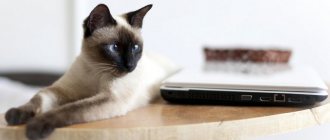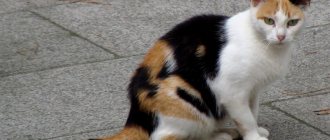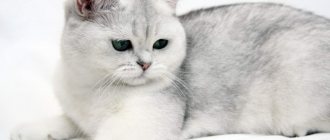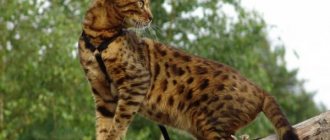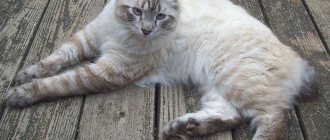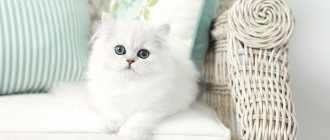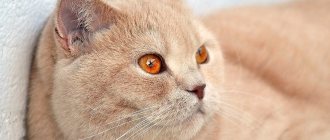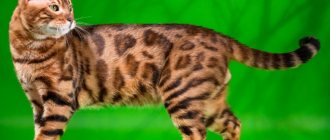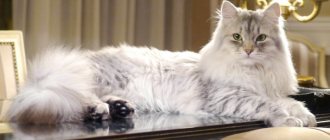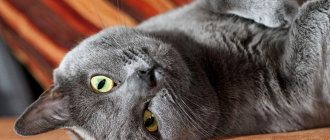Although many legends and traditions associated with cats have been preserved in the national Irish epic, this people never acquired their own breed. This is all due to the defeat of the independence fighters at the end of the 18th century, which ended with annexation to the British crown.
Along with the lands, local domestic animals also came under the rule of the empire. Since then, the term “Irish cat” has ceased to refer to one breed, but has become a collective image that combines several ancient breeds.
Highland Fold: keeping a purebred cat at home
Grooming.
Many potential owners of Scottish Fold long-haired cats may be seriously intimidated by their fur coat, since it is very difficult to care for. But this is not at all true, despite all the splendor of the fur of these purrs, it does not need any particularly complex and troublesome care. In general, in order for an animal to always look chic, it is enough to comb its coat 3-4 times a week using a medium-hard massage brush. You can also use a rubber glove - the choice is yours. During the molting period, this procedure should be carried out more frequently until daily combing; it is worth noting that pets do not shed very profusely. But when it comes to bathing, the opinions of scientists differ. Some advise washing cats frequently, while others recommend not to overuse this procedure, since a cat’s fur can lose all its splendor from interaction with water and detergents, especially those that are not of the highest quality. It should be noted that representatives of this breed do not have a special love for water, so in order not to stress your furry friend, bathe him when absolutely necessary; if this does not arise, then once every six months will be more than enough. Ear care. Due to the special structure of the auricle of fold-eared cats, caring for them is a little more difficult than for others. These cats also need to have their ears cleaned, but this needs to be done about 2 times a week. This procedure, which is not entirely pleasant for the Highland Fold, must be carried out using special cotton swabs with a limiter; it will prevent injury to the cat’s sensitive eardrum. As an aid, veterinarians advise using a special lotion for cleaning cats’ ears; it can be purchased at any veterinary pharmacy. Many cat owners often neglect this hygiene procedure, considering it not particularly necessary, but this is not so. Earwax, dirt particles and dead epidermis accumulate in large quantities in the external auditory canal of the animal. If all this “good” is not removed, the consequences can be fatal, even to the point that the cat may lose hearing. In addition, such an environment is simply a resort for ear mites, which can cause a disease such as otodecosis. Most often, ticks infect small kittens. The first symptoms of this disease are severe itching and profuse brown discharge. If you notice something similar to a Highland Fold, you should immediately show it to a veterinarian for diagnosis and subsequent treatment.
It is important to know that sometimes ear mites can come out of the ear canal and spread to the cat's body and be transmitted to another pet. Therefore, if you have, for example, a cat and a dog, then it is recommended to show it to a doctor.
These ear mites are not dangerous to humans.
Teeth. These purrs need to brush their teeth in order to prevent the deposition of tartar and the occurrence of inflammatory diseases of the soft tissues of the oral cavity. The optimal frequency of brushing teeth is 2-3 times a week; you can also add special food for cleaning teeth to your cat’s diet.
Eyes should be wiped once a week with a cotton pad soaked in a disinfectant solution.
What to feed? The Highland Fold's diet should be balanced; the best option would be ready-made food, both dry and wet, of good quality. It is best to give preference to premium and super premium food. Additional vitamin complexes will not be superfluous, especially during the molting period.
Basic moments
- The American Curl exists in two separate types - shorthair and semi-longhair (in the FIFe system it is positioned as longhair). Despite the fact that the standard considers both varieties to be equal, breeders around the world continue to give preference to semi-longhaired Curls as more glamorous and photogenic pets.
- The genetic mutation responsible for the shape and position of the ear cartilage does not have a negative impact on the health of animals. Moreover, American Curls have an unexpectedly strong immune system for purebred cats.
- American Curls are pets with a fine mental organization, loving people more than other cats. They are unobtrusive and do not make deafening “oratorios” if they are hungry or disagree with something.
- The breed is distinguished by a high level of intelligence and trainability (as trainable as a cat can be).
- American Curls have a peaceful nature, which helps them share housing with other cats and even dogs. In addition, they are very supportive of children.
- The playful paws of curls expertly open kitchen cabinets and press door latches until they switch to the position the cat needs.
- Adult kitties retain their playfulness and childlike spontaneity until old age, for which they are called cats with the character of Peter Pan.
- Thin, as if curled with curlers, the ears of American Curls have harder cartilage than the ears of ordinary cats, and are easily injured. In general, get ready to explain to guests for a long time and convincingly why you do not allow your cat to be stroked on the head.
- American Curl kittens are born with straight ears that begin to curl only at 3-10 days of age. The degree of curl of the cartilage can be different: from minimal to miniature “roll”.
American Curls are affectionate, courteous intellectuals, memorable for their extraordinary image and fantastic sense of affection for a person. Moderately balanced, but far from phlegmatic, they masterfully break any stereotypes regarding the cat tribe. Independence, a stubborn reluctance to share territory and the owner with other pets, a passion for solitude - all this is not at all about curls, who consider such habits the height of bad manners. It would not be an exaggeration to say that this is one of the most positive breeds, whose representatives desperately do not want to grow up, therefore, at the advanced age of ten years, “bow-eared” cats are as playful and easy-going as in their youth.
Care and nutrition of the Highland Fold cat
Savannah cat: description of the breed, character, features
Like any domestic animal, this Scotsman requires careful care. The whole difficulty of care lies only in its regularity. Silky wool does not get tangled, but it needs to be combed once a week to ensure that the owner’s carpets and upholstered furniture remain free of hair.
And with such care, the beauty will have a more polished appearance. Ears and eyes must be cleaned. To do this, you need to examine your pet daily. A healthy cat's eyes are clean and there is no need to touch them unnecessarily, but the ears should be examined more carefully.
In order for these procedures to be easy, the kitten should be accustomed to them from the very first days of acquisition. To do this, you need to carefully and carefully touch the ears very often, ensuring that the kitten no longer notices these touches.
Also, during training, you should pay attention to the fact that the kitten remains motionless for some time, that is, does not break free, does not run away, does not scratch
After all, when cleaning the ears, the calm state of the animal is extremely important. The cat's food must be of high quality
The cat's food must be of high quality.
Specialized stores have a wide range of ready-made food, so your pet should choose the one that suits him best. A very correct decision would be to consult with the breeder; the food of a mother cat is most often ideal for her children. You should be careful - Highland Fold cats love to eat, so you should not feed your pet; excess weight is harmful not only to humans, but also to animals.
Plain (solid, solid)
Golden chinchilla cat. description, features, care and price of the breed
The monochrome uniform coloring of Scottish cats is considered classic by breeders. The solid or solid color of the animal implies the absolute exclusion of any inclusions, small marks and specks of a different color. The tone is rich, even along the entire length of the coat.
The most common used to be considered blue plain Scots. But today among the representatives of the breed there are many other variants of solid colors.
White
A Scottish cat with snow-white fur (without yellowness) looks luxurious. Possible eye colors are blue, amber, copper. According to the standard, eyes of different colors are allowed. The paw pads and nose are light pink.
Kittens may have markings of a different shade, which disappear after the first coat change. By the age of two, the coat of a white Scot should be crystal clear, without spots of a different color.
Black
The black cat has expressive yellow eyes. The nose and paw pads practically blend into the main color of the animal.
On the shiny bright coat of the Scottish beauty Ebony, 2-3 hairs of contrasting white color are allowed. The presence of large red or brown marks is not provided for by the standard.
Chocolate
The brown Scottish cat, also called chocolate, looks noble and impressive. The color of the coat contrasts with the animal's yellow, golden or copper eyes. The nose and paw pads are also dark brown.
Lilac (lavender)
The monochromatic lilac Scottish Fold has a gentle gray tint that smoothly turns into cream. The nose is slightly brownish, the paws on the bottom are the same color as the coat, in harmony with the main color of the pet. This lilac-lavender color goes well with eyes of copper, amber or orange shades.
Red (red)
Red or ginger color is a rare and valuable color of the Scots breed. The fiery edge is combined with burning amber irises. Pads and nose to match the dominant color.
The tail of kittens and adult animals is not very evenly colored. This deficiency does not disappear with age and is allowed by the standard. And the presence of marks on the head and limbs that remain after reaching the age of two are considered a deviation from the norm.
A red Scottish straight-eared cat can give birth to kittens not only with erect ears, but also with ears pressed to the head.
Cream
The cream or peach fold cat is infinitely elegant and beautiful. The delicate background of light fur, bright golden eyes and a pinkish nose give the pet an irresistible appearance. The pads on the paws are also pink. An animal with this color is similar to a red Scotsman, but its coat color is a shade lighter.
A peach fold kitten may have a blurry, fuzzy pattern on its paws and tail that does not disappear with age. This is not critical for a purebred pet, but leopard markings are absolutely unacceptable.
Faun (deer)
There is another unique color of Scottish fold cats with an interesting name - fawn, which means “young deer”. The nose and pads on the paws of these beauties are beige-pink.
Cinnamon
Cinnamon is a lighter and more delicate color than chocolate, but darker than red. The nose and paw pads of such animals are brown, beige or pink.
Blue color (blue)
The gray or blue Scottish cat has very beautiful amber eyes. The coat tone of a purebred pet can belong to any range of gray - from the lightest (blue) to completely dark (blue). At the same time, each hair is saturated and well colored, without streaks.
The nose and pads practically do not differ in color from the plain coat.
A gray Scottish Straight cat may be marked with a few streaks and drawings in childhood. But as they grow older, these color flaws go away.
Shaded (shedded) colors
Scientists have learned and shown how cats, dogs, snakes and other animals see
An unusual definition refers to the interesting color of Scottish cats - shaded colors. These pets have almost white fur, but the tip of the guard hair is colored.
The top layer of a cat's coat can be any shade typical of Scottish cats. The undercoat is white. The sides, back, head, tail and ears are shaded. Light belly, chin and lower tail. There should be no obvious spots. The “M” sign on the forehead and darkish rings on the paws are acceptable.
Shedded colors can be of three varieties:
- Golden. The fur of the Scottish cat is golden, the undercoat is cream or light peach. Green eyes are very expressive and beautiful. The nose button and paw pads are chocolate.
- Red. This type of shaded color has a dark red coating on the coat with a snow-white undercoat. The eyes are amber, the pads and nose are pink.
- Silver. The white undercoat combined with the dark gray topcoat produces an amazing gray tint. Greenish eyes are lined with black stripes. This feature is typical only for the silver shedded color. Other varieties have eyes without a contour. The nose is brick-colored and the mouth is dark-lined.
What does the price depend on?
- Pedigree. First of all, the price of any individual (in qualified nurseries) depends on the pedigree. For example, if the kitten’s parents participated in various exhibitions and took places, then their kitten will accordingly cost more than the one whose parents have a less vibrant and voluminous pedigree.
- Floor. A female will be slightly cheaper than a male.
- Purpose. It depends on what purpose you are purchasing the animal for. There are two options: either as a pet, or for exhibitions and further breeding. Then you need to look at what class the cat belongs to (described in more detail in the next paragraph) and look at the prices.
- Age. The point is quite important, since most often grown-up individuals are sold cheaper than kittens (2.5-3 months)
- Color. This is also an important point that affects the cost. Rarer colors tend to be more expensive than common ones.
Chantilly Tiffany cat. description, features, care and price of the breed
We are different, but we have a lot in common... or breed standards
All representatives of the Scottish breed, except for differences in the position of the ears and the length of the coat, are built almost identically. These animals are small in size, but have a proportionally built body with well-developed muscles. The paws are round, muscular, well developed, and of medium length. All cats have a compact, round head, which is located on a short, strong neck. All animals, regardless of subspecies, have large, round, wide-set eyes, which makes them look like an owl. The length of the tail varies among the subspecies, but all have a characteristic rounding at the tip caused by a shortened tendon.
The colors of representatives of the Scottish breed are very diverse: from the most ordinary, plain, smoky and tortoiseshell, to the unusual and rare tabby, van, tiki.
What do the Scots get sick of?
Like most animals, Scots tend to get sick, so regular examination by a veterinarian will certainly not harm them. Diseases specific to this breed include joint pathologies. Osteochondrodysplasia is the destruction of articular cartilage, an incurable and irreversible process. At the same time, the animal is limping, its movements are stiff, and movement is difficult.
In addition to joint problems, Scots are prone to obesity, and, as a result, heart problems. Cardiomyopathy, a disease accompanied by heart failure.
In all cases, it is strictly forbidden to self-medicate. The animal must be urgently shown to a specialist who will make a diagnosis and prescribe treatment.
Character and behavioral characteristics of the Celtic cat
The European Shorthair cat has a “comfortable” character. She is accommodating and loyal, and her habits and habits are shaped by the owner himself. In fact, the Celts are considered kind and peaceful, but it all depends on how a person will raise her. This cat will reciprocate anger and aggression, but at the same time will lose self-esteem and intelligence. The European cat also loves to play and be active. Thanks to this quality of a hunter, the Celt is considered an excellent mouser. The Celt's modesty and balance are evidenced by her silence - the European cat only speaks occasionally (for example, when the door to the toilet is closed).
They say about Celtic cats that their eyes are the mirror of the owner’s soul. Over the years, the cat adopts the habits of its owner, sometimes copying it. I recently noticed the same qualities in my cat. She is not purebred, but it seems to me that there were Celts in her family. I often notice that she prefers the same food as me (she, for example, does not ask for sausages when there are cucumbers on the table). We also wake up at the same time, according to the alarm clock. And if the alarm clock is far from me, but rings, she tries to stomp on it to turn it off. And then he goes to the kitchen and waits for breakfast.
Celtic cats have a truly “feline” character - they are free, playful and affectionate.
How does a Celtic cat live with other cats?
Despite her gift for adaptation, the European Shorthair will not tolerate another cat in her home. As the leader of the home, this cat agrees to recognize only a person, well, or herself. To avoid conflicts, it is advisable that only one cat live in a house/apartment. The same can apply to other animals.
Relationship between cat and people
When guests come to the owners of the European Shorthair cat, the animal shows its indifference. The Celt will not ask to be held in his arms to be caressed, but if he needs something, he will still get it. The Celt tries to communicate with children as equals. This cat will ignore arrogance and aggression if it considers a child to be its friend. Many cat owners consider Celts to be intelligent cats, capable of understanding human language.
The Celtic cat is the “golden mean” (it is unobtrusive, but affectionate, a leader, but not an aggressor)
Character
Scottish Straights have an easy-going disposition. They are kind, playful, independent. They are willing to be held, but still prefer to lie next to them. They don’t jump high, at most on window sills and tables. They love toys; when they are not there, they begin to use any small objects, socks, gloves. However, they rarely create a mess.
Long loneliness has a depressing effect on them. They don’t impose their company; they will find something to do on their own. They tolerate large numbers of guests well and are not afraid of strangers. They quickly adapt and get used to it. They are highly intelligent and loyal. Frequent, sudden changes in environment cause them stress. But in general they are emotionally stable, without sudden mood swings.
How do they get along with family members?
Children are treated calmly, patiently, without aggression. To cause it, you will have to drive the cat crazy for a long time. They avoid active, noisy games, so they prefer to stay on the sidelines. Although we are always ready to play a little. Usually they become more attached to one of the adults who will receive more attention.
Relationships with other pets
They get along well with other relatives and dogs. Scottish Straights do not strive to lead or emphasize their superiority; they prefer to remain neutral. However, the hunting instinct prevents it from being preserved in relation to birds, hamsters, and guinea pigs. If another cat or dog appears at home where an adult cat already lives, he will be wary at first, but will quickly get used to the new residents.
Training and education
Scottish Straights are smart and easy to train. They quickly start going to the litter box and remember where the bowls are. You can toilet train a two-week-old pet. If he has chosen the wrong place for this, the tray is placed there. Then the toilet is gradually moved every day until it is where it is needed.
Scottish Straights are easy to train. They can be taught the “no” command, do a “bunny”, give a paw, bring toys and balls. For each completed command they are rewarded with a treat. The main thing is that you can’t shout or hit, you have to be patient. If you punish undesirable actions, your pets will start doing things they shouldn’t do out of spite. At most you can take him by the scruff of the neck and scold him.
How many years can a cat live?
It is difficult to guess the age of a cat. Perhaps one of the reasons why they always look so great is that cats don't wrinkle or go gray the way humans do. Many cats are active throughout their lives. One English tabby cat is known to have killed a wild stoat at the age of 19, while another American cat has given birth to kittens at the age of 30.
Reports of cats reaching record ages appear regularly. Many of them cannot be proven because they rely on anecdotal evidence. There are several contenders for the title of the oldest cat in the world, and perhaps in the future there will be another pet who will live a few more years longer. At this point, it is likely that one of the oldest cats in history is a Texas cat named Creme Puff. Cream Puff is the official title holder of the Guinness Book of Records. Creme Puff was born in early August 1967 and lived into the new millennium. She died in 2005 at the age of 38.
On average, domestic cats are likely to live longer than wild cats, although the stress of indoor living, the risk of obesity (a leading cause of diabetes and heart disease), and lack of exercise cause the difference between the life expectancy of wild and domestic cats to be the average is not as great as many people believe. Long-lived cats tend to be animals that frequently spend time outdoors and have sufficient physical activity.
A good diet is very important for prolonging a cat's life, but the main factors appear to be genetic. Few of the millions of cats alive today will live to see their thirties. However, the average cat's lifespan is rapidly increasing as more and more cats begin to enjoy the benefits of a good diet and veterinary care. Barring illness or accident, there is no reason why a cat cannot live to be 20 years old, which is why the number of cats celebrating their twenty-first birthday increases every year.
Education and physical activity
Features of raising and keeping a cat directly depend on the nature of the breed:
The process of raising a Briton cannot be interrupted for a minute. Otherwise, this wayward cat will quickly imagine itself as the head of the family and begin to establish its own rules. By the way, the Briton willingly uses both teeth and claws.
The Scottish Fold is the exact opposite of the British cat breed. We can say that his delicacy knows no bounds. He can do something contrary to his beloved owner only in one case - from pain.
Characteristics of the Scottish breed
Scottish Folds have one obvious difference - folded ears. It is impossible to confuse these cats with anyone else. There are other distinguishing characteristics of the breed that you should know.
Standard
Scottish Folds resemble the British cat, as they are their closest relatives. But there are still differences. The description of the appearance of a representative of the Scottish Fold breed is as follows:
- Body: medium size, slightly elongated, with voluminous breasts. The limbs are round and of medium length, sometimes long.
- Head: rounded, blends smoothly into the neck. They have pronounced cheeks and a round chin.
- Eyes: round, widely spaced. Eye color depends on coat color; there are no specific standards.
- Ears: the main distinguishing feature of the breed. Small in size, widely spaced and curved forward. They have one, two or three folds. The more folds, the more they are pressed to the head and more closely follow its shape.
- Coat: Scots are typically short, plush, with a thick undercoat. There are also long-haired cats of this breed. They are called Highland Folds.
- Weight: on average from 3 to 8 kg.
- Color: any color is allowed according to the standards.
A little more about colors. The following types are distinguished:
- solid - a shade of one tone, any color: black, white, blue (cold gray), chocolate, lilac, red;
- tortoiseshell - spots of more than 2 different shades, harmoniously located throughout the body or throughout the entire coat except the chest and paws;
- smoky – plain outer coat with a silvery-white undercoat;
- chinchilla - the base of the hair color is white, and the eighth part is colored;
- tabby - color with brindle, striped, spotted or marbled patterns;
- bicolor - a combination of white with blue, black or red, preferably white on the legs, paws, stomach, chest, chin and part of the face;
- van – the main coat color is white, the tail and two spots on the head are of a different color;
- harlequin - the main part of the coat is white, and a fifth of it is of a different shade;
- colorpoint - the shade of the entire coat is light, and the paws, tail, ears and muzzle are of a contrasting color.
Health
The life expectancy of Scottish cats is on average 12-15 years. They are quite strong animals. They have good health until old age, with proper care and nutrition. But since the breed was created using genetic mutations, this left its mark on the health of the offspring. Folds have some hereditary diseases:
- The most common is osteochondrodysplasia. This is a genetic disease of the musculoskeletal system that causes impaired growth of cartilage and bones or their deformation.
- Entropion of the eyelid, which is removed with surgery.
- The development of cataracts and glaucoma is possible.
- Ear infections.
- Partial or complete deafness.
- The risk of developing obesity due to unpretentiousness in food.
Character
Scottish Folds are cats that are suitable for almost any family. Easily adapt to new surroundings. They are not intrusive, calm, soft and peaceful animals. Of all the family members, they choose one favorite, which they consider their master. In his absence, they will be bored, and when he appears at home, they will follow on his heels.
These cats do not show aggression or too much activity. Scottish Folds divide their day into approximately 2 equal parts: active with games and exploration of the apartment, and sleep. The Scots like to lie down in some interesting position, for example, lying on their backs and spreading their paws. Or stand in the meerkat pose on your hind legs.
The Scots get along well with children. They will be able to steadfastly endure the attacks of their little owners, but this does not give children the right to mock the pet. You can simply rest assured for your child if he accidentally grabs or strokes the cat more than usual. The Scots react absolutely calmly to dogs. The Scots also have special sounds. They do not purr like ordinary cats, but make something similar to a quiet squeak.
Representatives of this breed are trainable. It's easy to teach them to go to the litter box. Due to their flexibility, they can easily master simple tricks. With the right amount of patience, you can teach a Scot to use the toilet as his toilet.
Description of the British
A century and a half ago, the British Isles were considered the world felinological center. Exotic cats came here along with the military and merchants from the East. It was during this period that the crossing of local animals with those brought on ships from distant countries began.
Thus, the Irish cat breed completely merged with the new English population.
The ancestors of ordinary British cats came to the islands with the Roman conquerors. It is believed that these were representatives of the Egyptian cat breed, but there is no factual evidence of this.
In England, they adapted to new climatic conditions, acquired thick hair and established family relationships with local four-legged rat catchers, among which a branch of Irish cats was already represented.
This is how a group of British cats was formed, which was later recognized as an aboriginal breed with certain external characteristics:
- Stocky animals with a harmonious physique.
- Gray-blue color, traditional for the British breed.
- All the lines of the body and head of the British are smooth - even the tail ends in a slight curve.
- The ears are set wide, forming an equilateral triangle between their bases and the nose.
- Round cheeks.
- Low legs with round, powerful paws.
- The most common eye color is honey-amber, but green, blue and even lavender are also acceptable.
The descendants of Irish cats are distinguished by good health. They often live to an old age (20 years), and do not suffer from chronic diseases.
Nutrition
An important aspect of caring for Scottish Folds is food. Nutrition should be regular and balanced so that the pet is always strong. The best option is a harmonious diet based on natural ingredients.
You can also choose good bagged food. Experts and nurseries recommend a varied diet that contains both natural ingredients and cat food. You should always remember to drink regularly.
The water in the bowl should be renewed daily, no matter how much you drink. It is normal for adults to eat 2-3 times a day. You should not change the types of food frequently, so as not to get a stomach ache.
It should be remembered that cats are contraindicated from eating foods with a lot of fat, with vinegar and salt, fried foods and containing sugar. Seasonings and hot and cold foods should be avoided.
Good for Scottish Folds:
- lean meat;
- fish;
- milk;
- cottage cheese.
Vegetable ingredients, fresh and boiled, and all sorts of cereals are needed.
It is not advisable to give:
- eggplant;
- tomatoes;
- onion;
- garlic.
History in the chronicles and the actual origin of the Irish cat
10 centuries ago, Welsh laws determined not only the social structure of the territory of Wales, but even such little things as the cost of a domestic cat - 4 pence. At the same time, an age gradation was provided:
- from birth to the moment the eyes open, an Irish kitten cost 1 penny;
- after the first mouse killed, the price increased to 2d;
- As soon as an Irish cat became a full-fledged hunter, it was already valued at the full amount - 4 pence.
The Irish also added a cat to the list of things necessary for every housewife.
If someone's cat was killed by an Englishman, he was obliged to compensate for the damage with a lamb or an adult sheep. Sometimes they paid in grain - a pile of wheat had to cover the entire length of an Irish cat. But the presence of a domestic rat catcher at a housewarming party, unlike Russian tradition, was not allowed.
The patron saint of Irish cats was Saint Patrick himself, but this did not save the local breed from extinction. As soon as power passed to Britain, the history of a separate species ended, and a new page in the cat's pedigree opened.
https://youtube.com/watch?v=NVYuNryHbR0
LiveInternetLiveInternet
Quote from cats-witch
Read in full In your quotation book or community!
From surviving Irish legends it follows that the cat, like many other
Celtic mythical animals
, was formerly human. According to legend, “a cat’s eyes are windows that allow us to look into another world.” Cats in Ireland
are endowed with mysterious power, especially white ones, since this color has a sacred meaning.
A white cat, according to the Irish, is capable of protecting the clan it protects from troubles and misfortunes. It is not for nothing that already in the fifth century a cat was included in the list of things necessary for every Irish housewife. In the 9th century, an image of a cat is found in the famous Irish manuscript “ The Book of the Celts
”.
An Englishman who killed someone else's cat had to give a lamb or even a sheep in return. In some places, a fine was levied on the killer - so much grain that, when poured into a mound, it would completely hide the animal underneath, suspended by the tail and touching the ground with its muzzle. But not everything was so rosy in the life of Irish cats. In ancient times, sorcerers and soothsayers had a tradition of eating cat meat. It was believed that cats have magical powers, and in particular they can look into the future, as well as control the nature around us. An echo of this has come down to our times in the old Irish belief that “if you put a cat in a pot, the weather will be bad.” One legend is also interesting, which states that Irish warriors were very fond of decorating their helmets with cat tails, and therefore mother cats, fearing for the lives of their cubs, immediately bit off their tails at birth. As a result of this, Manx tailless cats appeared in nature.
It is noteworthy that in the old days the Irish used the blood of black cats to treat erysipelas. Calling this disease “wild fire,” they believed that it was caused by damage caused by fairies. To remove this damage, blood had to be shed. The blood of a black cat was considered the most suitable, and the usual way of obtaining it was to cut off a piece of the cat's tail (and not the ear, as in Scotland) and smear the blood on the sore spot.
Image by Ryan Conners
Be that as it may, Irish cats now live quite comfortably.
Often, modern cats, having a caring owner, visit two or three more neighboring houses, considering themselves housewives there and eating almost equally with other family members. Neighbors buy food specifically for other people's animals, thereby unwittingly contributing to the development of obesity in all cats in the area. It should be noted that the “Irish cat” breed does not exist as such, but there is an outdated term that causes some confusion. “Irish Shorthair” - this is what was once proposed to be called the old type of British Shorthair cats (which existed before the Second World War), in order to distinguish them from the modern “British” cats (restored after the war). As for the “Irish spotted cat” breed, this is most likely a marketing term coined for the sale of outbred long-haired tortoiseshell cats. Interesting fact:
The smallest city in Ireland - Kilkenny - until the mid-19th century consisted of two cities - Irish and English. As legend has it, two cat tribes lived in Kilkenny, one of which lived among the English, and the second among the Irish. These cats constantly fought with each other, but victory always remained with the Irish side. Since then, the indomitable feline spirit has become associated with the character of the Kilkeneans.More interesting:Éire - Irish proverbs and sayings
St.Patrick 's Day
Irish cats -1 Cats in Ireland - 2. Fighting cats.
Cats in Ireland - 3. Cats of the Donegal family.
Irish Cat Pub
This Beautiful Ireland - Mount Stewart Gardens
St. Patrick's Day - March 17
History of the Scottish Fold cat breed
Typically, the appearance of new breeds is preceded by long-term, targeted selection work. In the case of the Scottish Fold, the situation is different.
The first mention of cats similar to the Scottish Fold is found in literature describing white long-haired cats living in China. At one time, representatives of this breed were even called Chinese - it was believed that they live only in this eastern country.
However, in 1961, the first cat with such a characteristic ear shape was born on a Scottish farm. They named her Susie. The mother of the unusual kitten was an ordinary semi-wild tabby, and the father remained unknown. Among the kittens that Susie regularly brought in were babies with very unusual ear shapes. One of these cats fell into the hands of Mary Ross in 1963. She was given the name Snooks. In her very first litter, Mary discovered a white kitten, whose appearance made it clear to the owner that she might be present at the birth of a new breed. To test her assumptions, she crossed the older kitten with a British Shorthair cat, and Snooks with a British Blue cat. As a result of the experiment, kittens were born, which became the first representatives of the Scottish Fold. The algorithm for breeding the breed was put on a scientific basis by professional breeders and geneticists. It was found that the characteristic lop ear is caused by the presence of a special gene Fd. In the case of the combination FdFd, that is, when both parents had ears folded down, the offspring had very serious problems with the musculoskeletal system. Selection experiments have shown that health complications in kittens can be avoided only if one of the parents has erect ears. Born from animals, one of which had the “fold-eared gene” (Fd), and the other did not (fd), the babies could carry the external characteristics of both a cat and a cat. On this basis, until recently, animals with straight ears were recognized as representatives of the British Shorthair. And only recently, felinologists identified a separate breed, which they called “Scottish Straight” (Scottish Shorthair). These cats have erect ears, and in all other respects they are exact copies of their fold-eared counterparts, which is why, in order to preserve the characteristic features, the Scottish Fold should only be mated with a straight cat.
The breed received official registration in 1994.
